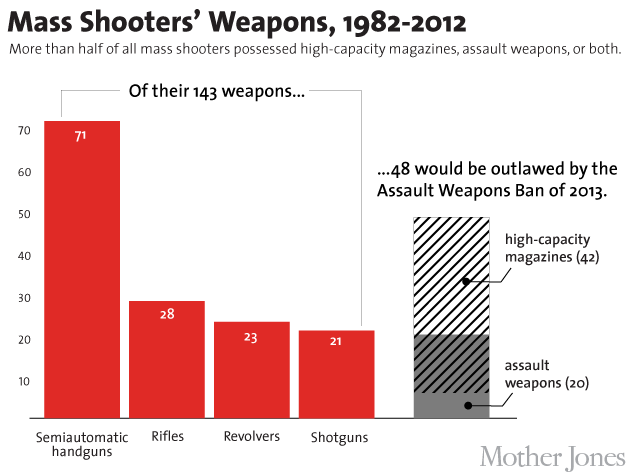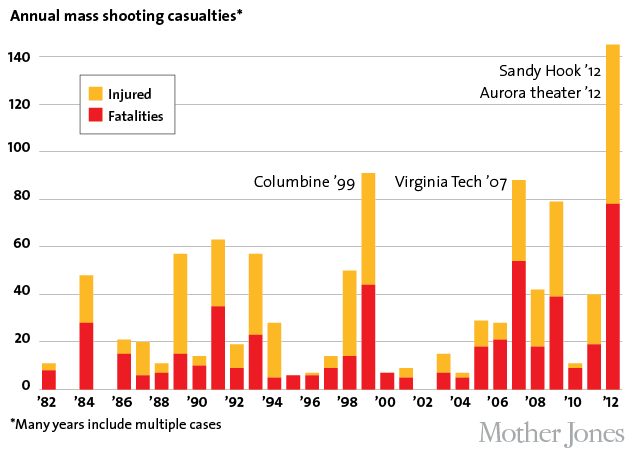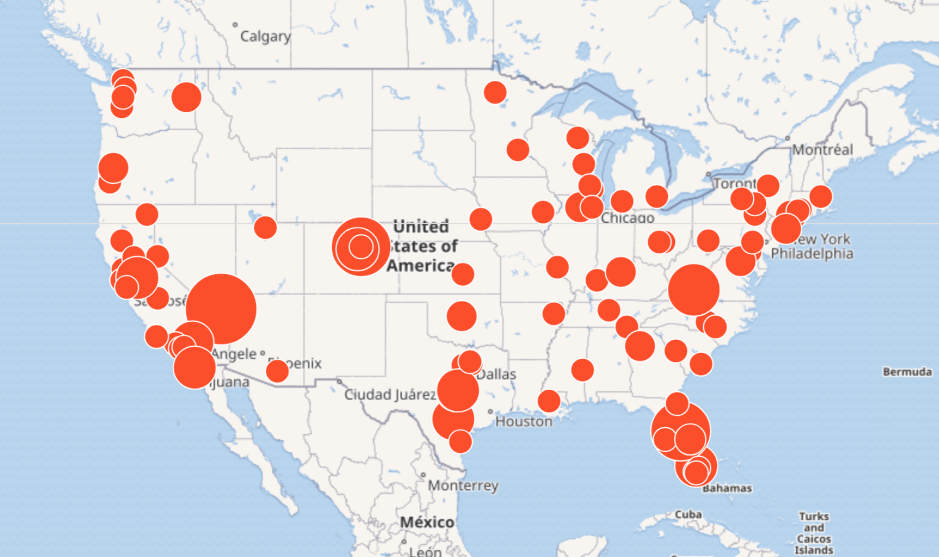
The political fortunes of the Assault Weapons Ban of 2013 have looked dim from the start. But as Congress considers the new legislation put forth by Sen. Dianne Feinstein (D-Calif.), one thing is clear: If it were to pass, the bill would outlaw highly lethal firearms that dozens of mass shooters in the United States have used to unleash carnage.
More than half of the killers we studied in our investigation of 62 mass shootings over the last three decades possessed weapons that would be banned by Feinstein’s bill, including various semi-automatic rifles, guns with military features, and handguns using magazines with more than 10 rounds. The damage these weapons can cause has been on grim display since last summer, from Aurora to Milwaukee to Minneapolis to Newtown, where attacks carried out with them left a total of 118 people injured and dead.
Ultimately, “assault weapon” and “high-capacity magazine” are political terms—there is no official or widely accepted definition for either, and different legislation has treated them differently. Feinstein’s new bill seeks to improve upon the 1994 ban she authored, which expired in 2004; gun manufacturers easily sidestepped that law by making superficial modifications to their weapons.
The new legislation aims to outlaw weapons that let a shooter fire a large number of bullets quickly without having to reload. Law enforcement officials we consulted generally considered that to be a reasonable approach for distinguishing between firearms used for sport or self-defense and military-style weapons designed to maximize body counts.
Using the parameters of the new bill, we dove deeper into the data on mass shootings that we first began gathering in July after the slaughter at the movie theater in Aurora, Colorado. We dug up additional specific details on the perpetrators’ guns and ammunition devices (often elusive, particularly with older cases). In our initial analysis we had used broader criteria for “assault weapons,” including some modified shotguns and bolt-action rifles; now, our more detailed chart and data set use four categories of firearms: semi-automatic handguns, rifles, revolvers, and shotguns. Across those four categories, we account for assault weapons and guns using high-capacity magazines that would be specifically outlawed by the new legislation. The data includes all guns recovered at the scene in each case, though not all of them were used in the crimes. Using this criteria we found:
- 42 guns with high-capacity magazines, across 31 mass-shooting cases
- 20 assault weapons, across 14 mass-shooting cases
- 33 cases involving assault weapons or high-capacity magazines (or both)
A total of 48 of these weapons (accounting for the overlap between the two categories) would be illegal under the new legislation.*
Feinstein’s Assault Weapons Ban of 2013 isn’t just about mass shootings, of course. By far the most common weapons used in these cases are semi-automatic handguns—the type of weapon also at the heart of the daily gun violence plaguing American communities. Banning high-capacity magazines may be especially key with regard to these guns, not only because they’re popular among mass shooters, but also because they tend to increase casualties in street violence, as a veteran ATF agent explained to us in a recent interview.
The devices have appeal on the streets. A Chicago high school student recently described his preference for 30-round magazines to a reporter for This American Life: “They got the most shots. You can shoot forever. Let out 15. Run back to where you going. Somebody else come out and let out five more. There you go.”
Don’t miss our yearlong investigation into gun laws and mass shootings. And click here for the full view of the below data set.
Correction: Due to a labeling mistake, the chart at the top originally showed a total of 62 weapons rather than 48.
















